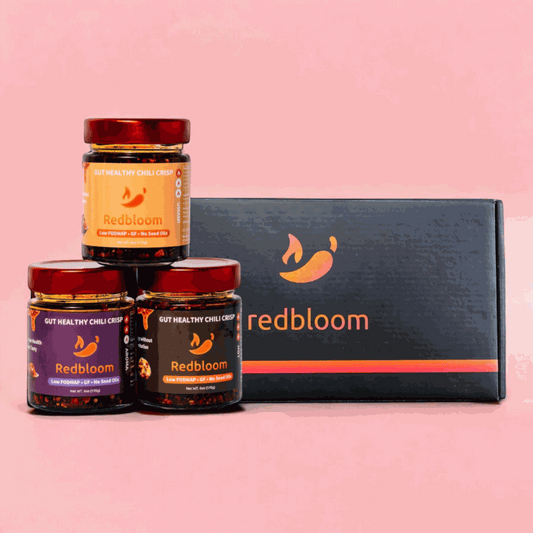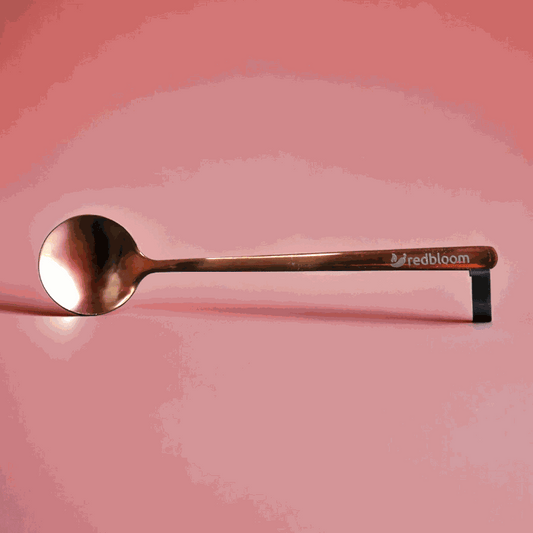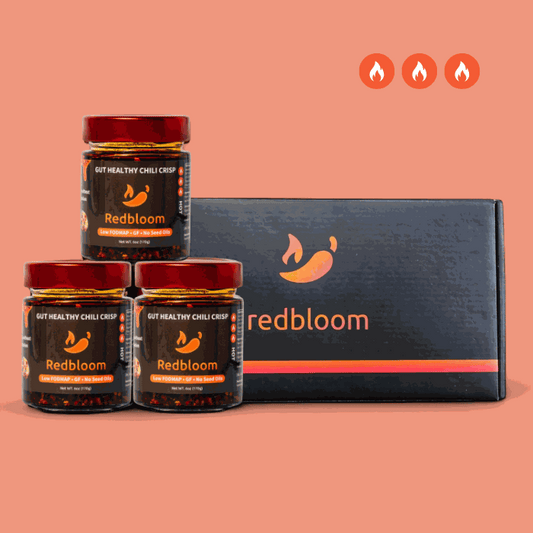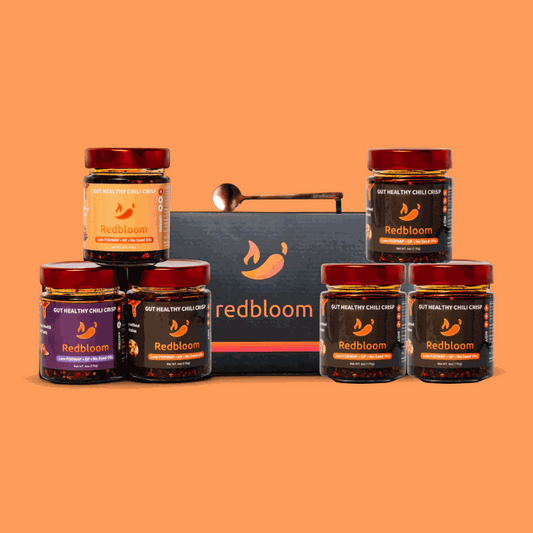Introduction
If you’ve recently gone through a gut healing journey or navigated an IBS flare-up, you’ve probably eliminated spicy foods from your plate. But once your symptoms are under control, that craving for chili crisp or hot sauce can come roaring back. The good news? With the right strategy, you can reintroduce spicy foods safely and enjoyably—without undoing your progress.
This blog is your complete, evidence-backed guide to reintroducing spice after a period of gut sensitivity. We’ll share practical steps, from choosing the right spices to monitoring symptoms, all designed to empower you—not overwhelm you—on your recovery path.
Why Go Slow with Spicy Foods After Gut Healing?
When your gut is healing, your nervous system is often still hyper-reactive—especially if you’ve dealt with visceral hypersensitivity. Capsaicin, the active compound in chili, activates TRPV1 pain receptors, which can trigger burning sensations, cramping, or urgency if reintroduced too quickly [1][2].
That’s why a slow, methodical reintroduction process is key to rebuilding spice tolerance safely.
Step 1: Achieve Symptom Stability
Before anything spicy touches your plate again, make sure your symptoms are consistently under control. This means:
-
Bowel habits have returned to baseline
-
Bloating, cramping, and urgency are minimal
-
No recent flare-ups or digestive setbacks
Jumping the gun can set your gut back and prolong your recovery. Patience here truly pays off [1][2].
Step 2: Start Small—Very Small
When it’s time to reintroduce spice, think microdoses. Try:
-
A pinch of pure chili powder
-
A few thin slices of mild pepper
-
1/4 teaspoon of infused chili oil on bland starches like rice or potatoes
Choose just one spicy food to test at a time and avoid mixing it with other potential gut triggers [1][2].
Step 3: Use the “Food Challenge” Method
Treat spice like any elimination reintroduction:
-
Introduce one spicy food at a time
-
Keep the rest of your diet Low-FODMAP and stable
-
Wait at least 2–3 days before trying another new spice
This spacing helps catch delayed reactions, which are common in IBS [1].
Step 4: Track Your Symptoms Like a Scientist
Use a journal or app to record:
-
The spicy ingredient used
-
The quantity
-
The time of day consumed
-
Any symptoms within 72 hours
Patterns will emerge and help you fine-tune what your gut can tolerate [1][2].
Step 5: Choose Low-FODMAP Spicy Ingredients
Not all spicy foods are equal. Some carry hidden triggers like garlic or onion. Choose:
-
Pure chili powder or paprika
-
Cayenne pepper (small amounts)
-
Garlic/onion-infused oils (safe for FODMAP-sensitive folks)
-
Fresh jalapeños (limit to one small pepper per meal)
Avoid: -
Premade spice blends with hidden FODMAPs
-
Vinegar-based hot sauces during early stages [1][3]
Step 6: Slowly Increase Serving Sizes
If no symptoms occur, increase portion size or intensity every few days:
-
Move from 1/4 tsp to 1/2 tsp chili oil
-
Try a slightly hotter pepper
-
Add spice to multiple meals per week
If symptoms return, scale back and try a milder alternative [1].
Step 7: Eat Spice with Gut-Soothing Foods
Balance spice with:
-
Starch (rice, oats, potatoes)
-
Low-fat proteins (chicken, tofu, eggs)
-
Cooling agents (lactose-free yogurt, cucumber, mint)
Avoid pairing with fatty or acidic foods, which can magnify capsaicin’s effects.
Step 8: Consider Long-Term Desensitization
There’s growing evidence that regular exposure to moderate capsaicin doses can desensitize gut TRPV1 receptors over time. This may reduce IBS pain and hypersensitivity—but it must be done slowly and consistently [1][4].
Expect initial flare-ups or discomfort as part of the adaptation process. Go slow and don’t rush.
Step 9: Work with a Professional
Every gut is different. A registered dietitian who specializes in IBS can guide your spice reintroduction, helping you troubleshoot setbacks and expand your diet safely [2][3].
Summary Table: Spicy Food Reintroduction for IBS
| Step | Action |
|---|---|
| Symptom Stability | Only begin when gut symptoms are well-managed |
| Gradual Introduction | Use tiny amounts; test one spice at a time |
| Symptom Tracking | Keep detailed records of intake and reactions |
| Low-FODMAP Ingredients | Avoid garlic/onion; use pure chili or oils |
| Portion Control | Increase slowly based on tolerance |
| Food Pairing | Combine with starch, protein, and soothing foods |
| Long-Term Tolerance | Consider microdosing for TRPV1 desensitization |
| Professional Guidance | Consult a GI dietitian or healthcare provider |
FAQs
1. Why can’t I just eat spice again once I feel better?
Your gut nerves may still be hypersensitive even if symptoms have improved. Jumping back into spicy food can restart symptoms if you’re not careful [1].
2. Is chili oil better than hot sauce?
Yes. Oil-based chili infusions are gentler on the gut than vinegar-based sauces, which can trigger acid reflux or gut irritation [1].
3. What if I try spice and get a flare-up?
Pause. Go back to a bland diet for a few days, then restart with half the amount. Don’t interpret one bad reaction as total intolerance [1].
4. Can I build up tolerance again?
Yes. Capsaicin desensitization is a real, evidence-backed process. It takes time, but regular exposure may reduce gut sensitivity long-term [4].
5. Should I avoid spice forever if I have IBS?
Not necessarily. Every gut is different. The goal is to personalize your diet—not restrict forever [1][2].
Conclusion
You don’t have to choose between gut comfort and flavorful food. With a little patience and a lot of strategy, spicy foods can make their way back into your life—even after IBS or gut healing.
Start small, track carefully, and remember: the goal isn’t perfection—it’s progress. Let your gut set the pace, and enjoy every small win on the way back to flavor.





